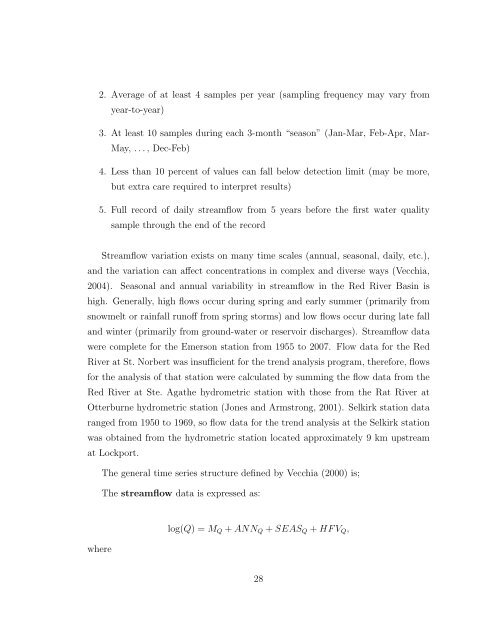Statistical Analysis of Trends in the Red River Over a 45 Year Period
Statistical Analysis of Trends in the Red River Over a 45 Year Period
Statistical Analysis of Trends in the Red River Over a 45 Year Period
Create successful ePaper yourself
Turn your PDF publications into a flip-book with our unique Google optimized e-Paper software.
2. Average <strong>of</strong> at least 4 samples per year (sampl<strong>in</strong>g frequency may vary from<br />
year-to-year)<br />
3. At least 10 samples dur<strong>in</strong>g each 3-month “season” (Jan-Mar, Feb-Apr, Mar-<br />
May, . . . , Dec-Feb)<br />
4. Less than 10 percent <strong>of</strong> values can fall below detection limit (may be more,<br />
but extra care required to <strong>in</strong>terpret results)<br />
5. Full record <strong>of</strong> daily streamflow from 5 years before <strong>the</strong> first water quality<br />
sample through <strong>the</strong> end <strong>of</strong> <strong>the</strong> record<br />
Streamflow variation exists on many time scales (annual, seasonal, daily, etc.),<br />
and <strong>the</strong> variation can affect concentrations <strong>in</strong> complex and diverse ways (Vecchia,<br />
2004). Seasonal and annual variability <strong>in</strong> streamflow <strong>in</strong> <strong>the</strong> <strong>Red</strong> <strong>River</strong> Bas<strong>in</strong> is<br />
high. Generally, high flows occur dur<strong>in</strong>g spr<strong>in</strong>g and early summer (primarily from<br />
snowmelt or ra<strong>in</strong>fall run<strong>of</strong>f from spr<strong>in</strong>g storms) and low flows occur dur<strong>in</strong>g late fall<br />
and w<strong>in</strong>ter (primarily from ground-water or reservoir discharges). Streamflow data<br />
were complete for <strong>the</strong> Emerson station from 1955 to 2007. Flow data for <strong>the</strong> <strong>Red</strong><br />
<strong>River</strong> at St. Norbert was <strong>in</strong>sufficient for <strong>the</strong> trend analysis program, <strong>the</strong>refore, flows<br />
for <strong>the</strong> analysis <strong>of</strong> that station were calculated by summ<strong>in</strong>g <strong>the</strong> flow data from <strong>the</strong><br />
<strong>Red</strong> <strong>River</strong> at Ste. Aga<strong>the</strong> hydrometric station with those from <strong>the</strong> Rat <strong>River</strong> at<br />
Otterburne hydrometric station (Jones and Armstrong, 2001). Selkirk station data<br />
ranged from 1950 to 1969, so flow data for <strong>the</strong> trend analysis at <strong>the</strong> Selkirk station<br />
was obta<strong>in</strong>ed from <strong>the</strong> hydrometric station located approximately 9 km upstream<br />
at Lockport.<br />
The general time series structure def<strong>in</strong>ed by Vecchia (2000) is;<br />
The streamflow data is expressed as:<br />
where<br />
log(Q) = M Q + ANN Q + SEAS Q + HF V Q ,<br />
28
















